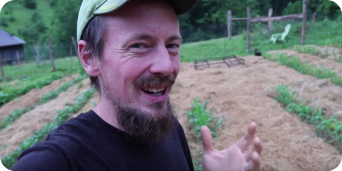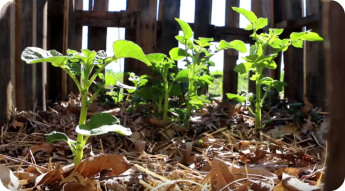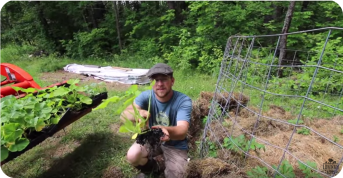3 Uses for Moldy Hay
Howdy, folks! Guess what? It rained today! My plants look so happy in the hoop garden this morning. We’re going through a drought in my area so a little rain makes a big difference. However, I had neglected to throw the tarp over some coastal hay and it got rained on. I was at first very upset with myself for wasting rabbit food. After whipping myself with a slew of curses, I pulled out as much wet hay as I could and set the rest to dry in the sun.
Now, I have a pile of wet hay. Over time, it will mold and could easily ruin the good hay. So, what do I do with this hay? I think to myself. Without a second thought, I grabbed it and stuffed the wet hay under the rabbit hutch. Oh, but why? Well… The bottom of the hutch is nothing more than “trash soil”. Adding hay would help increase the amount of carbon breaking down under the hutch, along with the rabbit manure and urine that provides a rich source of nitrogen. A mix of these products breaking down produces great compost! And guess who wants to sell compost to local nurseries?
Me!
But! You don’t have to line the bottom of your hutches to help compost beneath it. Moldy/wet hay can also be used in the garden, the compost bin, and even act as a planter! Below are three ways to use your moldy/wet hay along with instructions on how to do so. Also, I may name-drop some great vloggers that utilize the method I mentioned. I would recommend checking their channels out for additional information. If you have other methods for using moldy hay, let us know! We would like to add to this list in the future. Don’t be afraid to experiment either.
Mulch the Garden
As mentioned before, moldy hay breaks down over time to add carbon to the soil. This is rad fertilizer for your plants. This does take some time though, so why not use that hay to also protect the roots of your plants while it breaks down? rounded_corners 4Take some of that hay, scatter it evenly over the base of plants, and the hay provides natural shade and protection for the plant’s roots. Further, this mulch also helps in suppressing weeds and grass from overtaking your garden.

Youtube Homesteaders Art and Bri used this method in their huge garden. With a little help from family, the homesteaders were able to suppress weeds, protect roots, and even decrease the need to water. That’s right! Mulch helps keep water in the soil and reduce the need to water thirsty plants.
Encourage a Larger Yield of Potatoes
You will need to make sure you’re using the right seed potato for this method to work, but using moldy hay in a potato tower could help increase your crop yield. You don’t necessarily have to build a potato tower out of cattle panel for this to work, you could also use a large tub or even a kiddie pool. Fill the base of your tower with soil, then plant the seed potatoes. Cover the potatoes with soil and a bit of that moldy hay.
Wait…

When the potatoes begin to grow and you can see its little green sprout peeking up through the soil/hay, take some more moldy hay and cover the sprout. Repeat this step again and again as the sprout keeps growing up and up over time. The potatoes grow in the root system of the plant, not the green leaves. Therefore, covering the leaves and forcing it to grow taller increases the root structure and thus, a number of potatoes growing in the ground. rounded_corners 3Make sure, however, that your growing potatoes are covered completely at the roots. Potatoes exposed to sunlight turn green and are NOT SAFE TO EAT.
Doug and Stacy from Off Grid with Doug and Stacy used this method on their farm. Their tower did pretty well and I gotta say, those potato plants looked huge in their last update. I would recommend Banana and Rose Finn Fingerling Potatoes with this method, but German Butterball does well too!
Plant Directly in Moudly Hay
Yup, you can do this! If your moldy hay is still wrapped in its wire or plastic netting, consider using this bale as a planter. It would be best to use transplants and that your hay bale is composting. Place your moldy bale where you’d like and remove hay from the spots where you’ll be planting your transplants. Fill the hole with some soil, then place the transplant directly in it. rounded_corners PNG 1Cover the plant with more soil so that it is anchored in and has enough to eat. Water your completed planter bale and watch those plants go!

Al Lumnah used this method at Lumnah Acres to grow some squash plants. At first, they were a bit yellow but with some watering the transplants have perked back up and have even started producing flowers! The bale breaking down provides nutrients for the plants growing within it. Further, it retains water pretty well so your plants can be watered less. Some folks recommend conditioning your hay bale so that you have the best growth possible, but others have used new bales of hay with no problem. Experiment and see what works for you.
Which method do you think you’ll try first? Let us know in the comment section below. As always, be kind and tender to one another.
Did you miss our Cog Hill Farm and Homestead feature? Click here!
Image credit goes to Art and Bri, Off Grid with Doug and Stacy, and Lumnah Acres. See the original post at The Toasted Rabbit.
Nice article.
Around here hay costs a bit too much for us to use it as compost but I have been reading more and more about composting hay.
Just saw another article where you can grow right in a conditioned hay bale. Interesting.
If hay is too pricey, maybe consider leaf mulch or wood chips. To increase the nitrogen and carbon in the soil in one go, we house our chickens and quail over these mulching materials, let them get really manured, then add to the garden as needed. I'm even planning on winterizing the garden with these materials.
All the best with your future endeavors!
I hauled about 6 truck loads of tree mulch into our garden this spring. We put the mulch on the pathways and then around the plants. Worked well and kept the weeds down.
Chickens are providing fertilizer for us too.
We are trying to get the Back to Eden no till garden method going.
I want to try planting directly in straw or hay bales though. Looks cool.
Great work! Looks like you've got yourself set when it comes to mulching. If I remember correctly, some homesteaders condition their bales of hay by just leaving them inside their poultry coops, still baled. The chickens roost over them and manure the bales overtime. Others add nitrogen to them, spray their bales down, and even add minerals to help the hay be a little more plant friendly.
Lumnah Acres did the former method, letting the bales compost naturally over time, and then planted squash transplants straight into the bales. I would suggest watching his "How to Grow Food in Straw Bales". It's the same video I drew inspiration on for this post!
Thanks for the info. Chickens are great multi purpose animals.
p.s. please ignore the trolls who followed me. Sorry about that. I am on YouTube.
@thediyworld You don’t have trolls because you’re on youtube. You have trolls (critics) because you are a lying, ebegging con artist who deserves to be exposed.
@toastyrabbits, Unfortunately, what thediyworld failed to mention was he added that questionable "mulch" or yard waste to his already highly acidic soil, he didn't irrigate,
then sprinkled fertilizer directly on top of the plants,
which killed everything.
He likes to blame mother nature for his ineptness.
Claims it "freezes all summer" in Michigan.
He actually planted, had some sort of failure, and replanted 3 times this year.
He harvested some beans, some peas, and tomatoes.
Everything else died except the sunflowers and one squash that grew out of a compost pile on its own.
Oh, and he has yet to actually do a "Back to Eden" garden.
He likes to use that term for click bait.
I am not trying to dissuade you, just letting you know he has a habit of omitting important information, most times intentionally, for the last five years.
Best wishes to you.